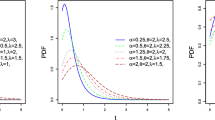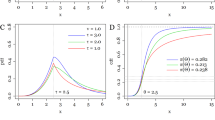Abstract
In this article, we propose a new three-parameter model called compound zero-truncated Poisson gamma model. The corresponding variate of this model represents the zero-truncated Poisson sum of independent and identically distributed gamma random variables. Several mathematical properties of the proposed model are discussed. The proposed model can be unimodal as well as multimodal, moreover, gamma distribution can be obtained as a special case. The model parameters are estimated using expectation–maximization (EM)-type algorithm, and it is observed that it is quite convenient to be implemented in practice. Furthermore, an extension of the model is made to consider four-parameter bivariate model, and derived estimation of unknown parameters and confidence intervals based on EM-type algorithm. For validation purposes, some numerical simulation experiments are conducted to check how the proposed EM-type algorithm performs. Finally, the analysis of real data set has been presented to show the flexibility of the proposed models.



Similar content being viewed by others
References
Asgharzadeh A, Esmaily L, Nadarajah S (2013) Approximate MLEs for the location and scale parameters of the skew logistic distribution. Stat Pap 54:391–411
Asgharzadeh A, Esmaeili L, Nadarajah S (2016) Balakrishnan skew logistic distribution. Commun Stat Theory Methods 45(2):444–464
Bakouch HS, Ristic MM, Asgharzadeh A, Esmaily L, Al-Zahrani BM (2012) An exponentiated exponential binomial distribution with application. Stat Probab Lett 82:1067–1081
Barreto-Souza W, Cribari-Neto F (2009) A Generalization of the exponential-Poisson distribution. Stat Probab Lett 79:2493–2500
Barreto-Souza W (2012) Bivariate gamma-geometric law and its induced l’evy process. J Multivar Anal 109:130–145
Charpentier A (2014) Computational actuarial science with R. CRC Press, New York
Dutang C, Charpentier A (2019) CASdatasets: insurance datasets. http://dutangc.free.fr/pub/RRepos
Emmer S, Kratz M, Tasche D (2015) What is the best risk measure in practice? A comparison of standard measures. J Risk 18(2):31–60
Evin G, Merleau J, Perreault L (2011) Two-component mixtures of normal, gamma, and Gumbel distributions for hydrological applications. Water Resour Res 47:W08525. https://doi.org/10.1029/2010WR010266
Grun B, Miljkovic T (2019) Extending composite loss models using a general framework of advanced computational tools. Scand Actuar J 2019(8):642–660
Gupta RD, Kundu D (2003) Discriminating between the Weibull and generalized exponential distributions. Comput Stat Data Anal 43:179–196
Kazemi R, Noorizadeh M (2015) A comparison between skew-logistic and skew normal distributions. Mathematika 31:15–24
Kozubowski TJ, Panorska AK (2008) A mixed bivariate distribution connected with geometric maxima of exponential variables. Commun Stat Theory Methods 37:2903–2923
Kundu D (2014) Geometric skew normal distribution. Sankhya B76(2):167–189
Kundu D, Nekoukhou V (2018) Univariate and bivariate geometric discrete generalized exponential distribution. J Stat Theory Pract 12(3):595–614
Kupiec P (1995) Techniques for verifying the accuracy of risk measurement models. J Deriv 3(2):73–84
Kus C (2007) A new lifetime distribution. Comput Stat Data Anal 51(9):4497–4509
Laird N (1978) Nonparametric maximum likelihood estimation of a mixing distribution. J Am Stat Assoc 73(364):805–811
Leinwander AJ, Aziz MA (2018) Modeling insurance claims using flexible skewed and mixture probability distributions. J Mod Appl Stat Methods 17(1):eP2467. https://doi.org/10.22237/jmasm/1525133100
Louis TA (1982) Finding the observed information matrix when using the EM algorithm. J R Stat Soc Ser B 44:226–233
Mahmoudi E, Jafari AA (2012) Generalized exponential-power series distributions. Comput Stat Data Anal 56:4047–4066
Raqab MZ, Al-Awadhi SA, Kundu D (2018) Discriminating among Weibull, log-normal, and log-logistic distributions. Commun Stat Simul Comput 47(5):1397–1419
Raqab MZ, Kundu D, Al-Awadhi FA (2021) Compound zero-truncated Poisson normal distribution and its applications. Commun Stat Theory Methods 50(13):3030–3050
Revfeim KJA (1984) An initial model of the relationship between rainfall events and daily rainfalls. J Hydrol 75(14):357–364
Sophia DW, Sanku D, Hrishikesh C (2017) A new generalization of the gamma distribution with application to negatively skewed survival data. Commun Stat Simul Comput 47(7):2083–2101
Tomarchio SD, Punzo A (2020) Dichotomous unimodal compound models: application to the distribution of insurance losses. J Appl Stat. https://doi.org/10.1080/02664763.2020.1789076
Tuneska BJ, Jolevski I (2013) Some results on the digamma function. Appl Math Inf Sci 1:167–170
Wahed AS, Ali MM (2001) The skew logistic distribution. J Stat Res 35(2):71–80
Acknowledgements
The authors would like to thank the associate editor and anonymous referees for their thoughtful remarks that greatly improved the presentation of this paper.
Author information
Authors and Affiliations
Corresponding author
Ethics declarations
Conflict of interest
On behalf of all authors, the corresponding author states that there is no conflict of interest.
Additional information
Publisher's Note
Springer Nature remains neutral with regard to jurisdictional claims in published maps and institutional affiliations.
Appendices
Appendices:
Here, we present some derivations for the Hessian matrix based on ZTP-EXP and BZTP-EXP models.
Appendix A: Hessian Matrix B and Vector S Components for UZTP-GA Model
with
and
Appendix B: Hessian Matrix B and Vector S Components for BZTP-GA Model
with
and
Rights and permissions
Springer Nature or its licensor holds exclusive rights to this article under a publishing agreement with the author(s) or other rightsholder(s); author self-archiving of the accepted manuscript version of this article is solely governed by the terms of such publishing agreement and applicable law.
About this article
Cite this article
Meraou, M.A., Al-Kandari, N.M. & Raqab, M.Z. Univariate and Bivariate Compound Models Based on Random Sum of Variates with Application to the Insurance Losses Data. J Stat Theory Pract 16, 56 (2022). https://doi.org/10.1007/s42519-022-00282-8
Accepted:
Published:
DOI: https://doi.org/10.1007/s42519-022-00282-8




